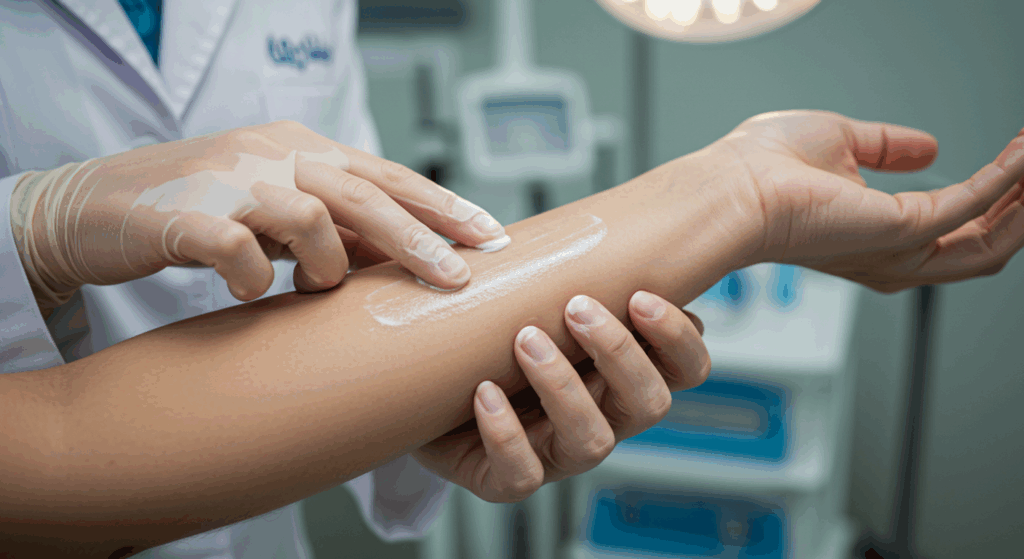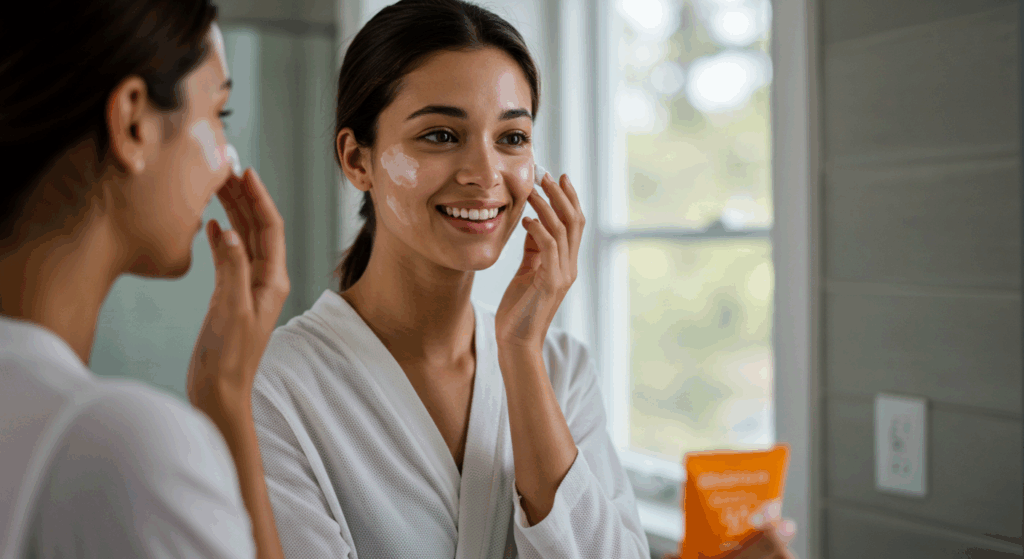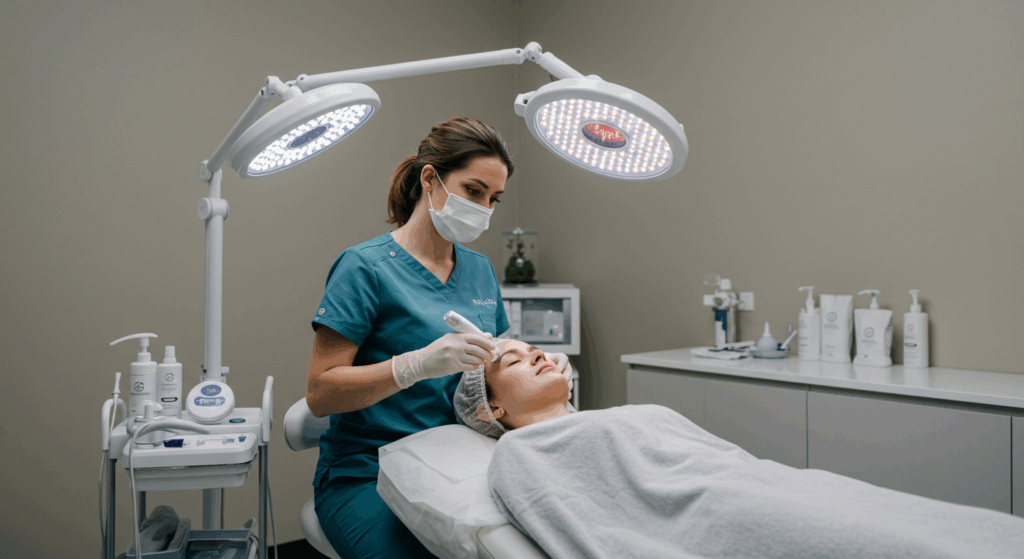Struggling with skin that flares up at the slightest provocation? If your skin reddens, itches, or breaks out from everyday products or environmental changes, you may be dealing with reactive skin. As a leading dermatologist in Antalya, Dr. Ebru Okyay understands the frustration of sensitive, reactive skin and the need for tailored solutions. In this comprehensive 2025 guide, discover specialized approaches to soothe and strengthen your skin barrier, drawing on the latest advancements in dermatology.
Reactive skin, often overlapping with sensitive skin conditions, responds intensely to triggers like harsh skincare, stress, or pollution. This guide explores evidence-based strategies, from gentle routines to professional treatments, to help you achieve calmer, healthier skin. Whether you’re seeking daily care tips or advanced therapies, these reactive skin solutions are designed to address your unique needs and restore balance.

Understanding Reactive Skin: Causes, Symptoms, and Diagnosis
Reactive skin is characterized by an overactive response to external or internal stimuli, leading to irritation and inflammation. Unlike normal skin, which maintains a stable barrier, reactive skin’s compromised barrier function allows irritants to penetrate easily, triggering a cascade of symptoms. In 2025, with increasing awareness of environmental factors, diagnosing reactive skin early is crucial for effective management.
Common Causes of Reactive Skin
Several factors contribute to the development of reactive skin. Understanding these can help in avoidance and prevention:
- Environmental Triggers: Pollution, UV exposure, and extreme temperatures weaken the skin’s natural defenses.
- Skincare Products: Harsh chemicals, fragrances, and alcohol in cosmetics can disrupt the skin microbiome.
- Lifestyle Factors: Stress, poor diet, and lack of sleep exacerbate inflammation.
- Underlying Conditions: Rosacea, eczema, or allergies often manifest as reactive responses.
In Antalya’s Mediterranean climate, sun exposure and humidity can intensify these triggers, making localized solutions essential.
Symptoms to Watch For
Recognizing symptoms is the first step toward relief. Reactive skin often presents with:
- Redness and flushing
- Itching or stinging sensations
- Tightness or dryness
- Breakouts or bumps
- Sensitivity to touch or temperature changes
If these persist, consulting a dermatologist like Dr. Okyay can provide a precise diagnosis through patch testing or barrier function assessments.
| Trigger Type | Common Examples | Impact on Reactive Skin |
|---|---|---|
| Environmental | Pollution, Sun, Wind | Barrier disruption, inflammation |
| Chemical | Fragrances, Preservatives | Irritation, allergic reactions |
| Internal | Stress, Hormones | Flare-ups, sensitivity increase |
This table highlights key triggers; for more on environmental impacts, explore our Hypoallergenic Skincare Guide.

Specialized Skincare Approaches for Reactive Skin
Managing reactive skin requires a gentle, targeted approach that repairs the skin barrier while avoiding irritants. In 2025, innovations in biotech and natural ingredients offer promising reactive skin solutions. Dr. Okyay recommends starting with a minimalist routine focused on hydration and soothing.
Building a Gentle Cleansing Routine
Cleansing is foundational, but for reactive skin, it must be non-stripping. Opt for micellar water or cream-based cleansers free of sulfates and essential oils. In the morning, a simple rinse with lukewarm water suffices to preserve natural oils.
Evening routines can include a barrier-repairing cleanser containing ceramides or niacinamide, which calm inflammation without compromising the microbiome.
Essential Moisturizers and Barrier Repair
Moisturization is non-negotiable for reactive skin. Look for products with hyaluronic acid, squalane, and colloidal oatmeal to lock in hydration and soothe irritation. Apply twice daily, massaging gently to enhance absorption.
- Use fragrance-free, hypoallergenic formulations
- Incorporate occlusives like petrolatum for overnight repair
- Patch test new products on the inner arm for 48 hours
For advanced options, consider our clinic’s recommended serums tailored for Antalya’s climate.
| Product Type | Key Ingredients | Benefits for Reactive Skin |
|---|---|---|
| Cleanser | Ceramides, Glycerin | Gentle removal without drying |
| Moisturizer | Hyaluronic Acid, Niacinamide | Hydrates and calms inflammation |
| Serum | Centella Asiatica, Panthenol | Repairs barrier, reduces redness |
Integrate anti-inflammatory ingredients; learn more in our Anti-Inflammatory Skincare Guide.
Sun Protection Tailored for Sensitivity
Sunscreen is vital, yet many formulas irritate reactive skin. Choose mineral-based SPFs with zinc oxide or titanium dioxide, which sit on the skin’s surface rather than absorbing. In 2025, tinted versions with soothing botanicals provide dual coverage.
Apply generously every two hours, especially in sunny Antalya. Reapply after swimming or sweating to maintain protection.

Lifestyle and Dietary Adjustments for Reactive Skin
Beyond topical care, holistic changes can significantly reduce flare-ups. Reactive skin often reflects internal imbalances, so addressing diet, stress, and habits is key to long-term reactive skin solutions.
Dietary Recommendations
An anti-inflammatory diet rich in omega-3s from fish, antioxidants from berries, and probiotics from yogurt supports skin health. Avoid common triggers like dairy, gluten, or spicy foods if they provoke reactions.
- Incorporate foods high in vitamin C and E for barrier support
- Stay hydrated with at least 2 liters of water daily
- Limit processed sugars that spike inflammation
Stress Management Techniques
Chronic stress elevates cortisol, worsening skin sensitivity. Practices like meditation, yoga, or even short walks in Antalya’s serene landscapes can lower stress levels. Aim for 7-9 hours of sleep nightly to allow skin repair.
For patients with persistent issues, mindfulness apps or professional counseling complement dermatological care.
Environmental Adaptations
In urban or coastal settings like Antalya, use humidifiers to combat dry air and air purifiers to filter pollutants. Wear protective clothing and hats during peak sun hours.
| Lifestyle Factor | Adjustment | Expected Benefit |
|---|---|---|
| Diet | Omega-3 rich foods | Reduced inflammation |
| Stress | Daily meditation | Lower cortisol, fewer flare-ups |
| Environment | Humidifier use | Improved hydration, less irritation |
These adjustments, when combined with professional guidance, yield transformative results. For chronic conditions, see our Chronic Skin Conditions Guide.
Professional Treatments for Reactive Skin in 2025
When at-home care isn’t enough, advanced treatments offer targeted relief. At Dr. Ebru Okyay’s clinic in Antalya, we specialize in minimally invasive options that prioritize safety for sensitive skin.
Topical Prescription Therapies
Prescription topicals like low-dose topical corticosteroids or calcineurin inhibitors (e.g., tacrolimus) provide rapid soothing. For barrier repair, compounded creams with growth factors are gaining popularity in 2025.
In-Office Procedures
Options include LED light therapy for anti-inflammatory effects, gentle chemical peels with lactic acid, or microneedling with soothing serums. These stimulate collagen without excessive irritation.
- Phototherapy: Red light reduces redness
- Laser Treatments: Pulsed dye lasers target vascular components
- PRP Therapy: Platelet-rich plasma enhances healing
Always start with a consultation to customize treatments. Visit our Advanced Dermatology Services for details.
| Treatment | Duration | Suitability for Reactive Skin |
|---|---|---|
| LED Therapy | 20-30 min | Non-invasive, soothing |
| Gentle Peel | 15-20 min | Mild exfoliation, minimal downtime |
| PRP | 45 min | Natural healing booster |
These 2025 advancements ensure effective, gentle care. For cosmetic enhancements, check our Cosmetic Dermatology page.
Emerging Trends and Innovations
Looking ahead, microbiome-targeted probiotics and AI-personalized skincare regimens are revolutionizing reactive skin management. Clinical trials show promising results in restoring balance without steroids.
Dr. Okyay stays at the forefront, integrating these into patient plans for optimal outcomes.
Conclusion
Key Takeaways
- Reactive skin stems from barrier dysfunction; identify triggers early for better control.
- Gentle, minimalist routines with ceramides and niacinamide form the core of daily care.
- Lifestyle tweaks like anti-inflammatory diets and stress reduction amplify results.
- Professional treatments, from topicals to LED therapy, offer advanced relief when needed.
Next Steps
Empower your skin health today:
- Assess your current routine and eliminate irritants.
- Schedule a consultation with Dr. Ebru Okyay for personalized advice.
- Explore our clinic’s hypoallergenic product recommendations.
- Track flare-ups in a journal to identify patterns.
Frequently Asked Questions (FAQs)
What is the difference between sensitive and reactive skin?
Sensitive skin is generally prone to irritation, while reactive skin specifically flares up in response to triggers, often with visible inflammation. Both benefit from gentle care.
Can diet affect reactive skin?
Yes, an anti-inflammatory diet can reduce flare-ups by supporting the skin barrier from within.
How long does it take to see improvements?
With consistent care, improvements can appear in 2-4 weeks, though full barrier repair may take months.
Are natural ingredients always safe for reactive skin?
Not necessarily; even naturals like citrus can irritate. Patch testing is essential.
When should I see a dermatologist?
If over-the-counter solutions fail or symptoms worsen, professional evaluation is recommended.
Is sunscreen necessary for reactive skin?
Absolutely; opt for mineral-based to avoid chemical irritants while protecting from UV damage.
At Dr. Ebru Okyay’s clinic in Antalya, we’re committed to providing expert care for reactive skin. Contact us today to start your journey to calmer skin.
